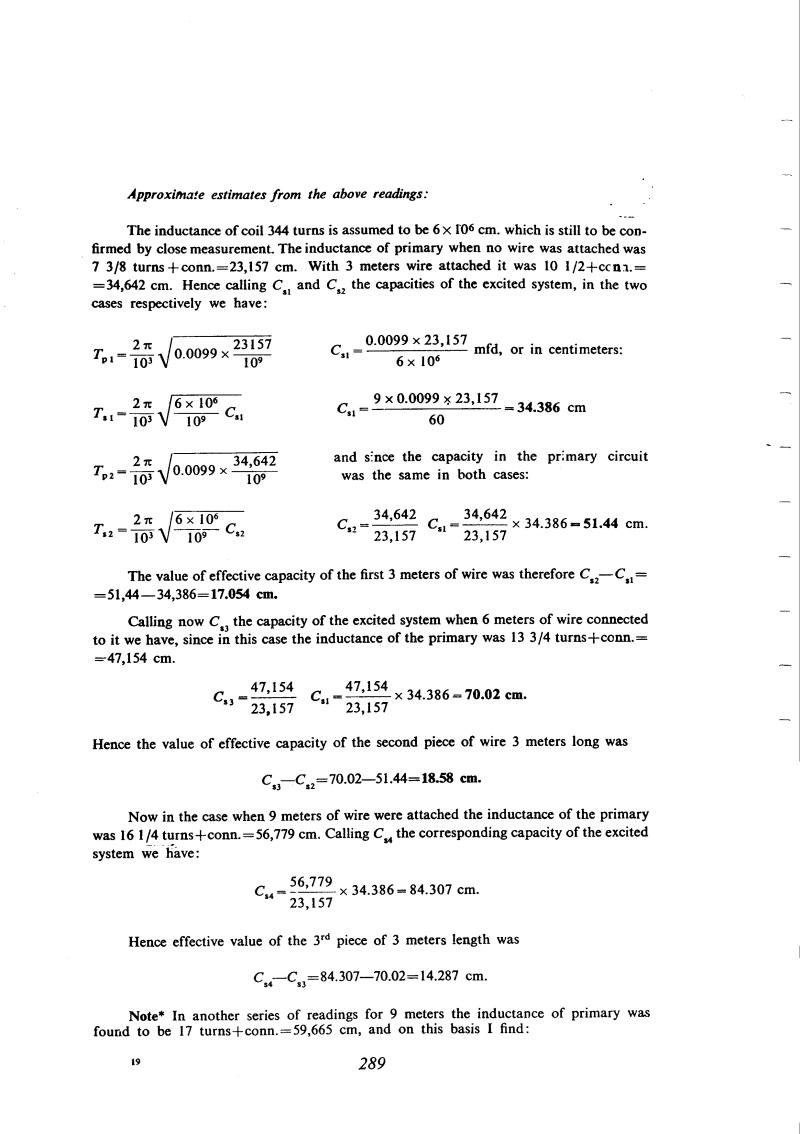
Nikola Tesla Books
Approximate estimates from the above readings:
The inductance of coil 344 turns is assumed to be 6 x 106 cm. which is still to be confirmed by close measurement. The inductance of primary when no wire was attached was 7 3/8 turns + conn. = 23,157 cm. With 3 meters wire attached it was 10 1/2 + conn. = 34,642 cm. Hence calling Cs1 and Cs2 the capacities of the excited system, in the two cases respectively we have:
Tp1 = $! {{2 \pi \over 10^{3}} \sqrt{0.0099 \times {23157 \over 10^{9}}}} $!
Ts1 = $! {{2 \pi \over 10^{3}} \sqrt{{{6 \times 10^{6}} \over 10^{9}} {C_{s}}_{1}}} $!
Tp2 = $! {{2 \pi \over 10^{3}} \sqrt{0.0099 \times {34,642 \over 10^{9}}}} $!
Ts2 = $! {{2 \pi \over 10^{3}} \sqrt{{{6 \times 10^{6}} \over 10^{9}} {C_{s}}_{2}}} $!
Cs1 = $! {{0.0099 \times 23,157} \over {6 \times 10^{6}}} $! mfd, or in centimeters:
Cs1 = $! {{9 \times 0.0099 \times 23,157} \over 60} $! = 34.386 cm
and since the capacity in the primary circuit was the same in both cases:
Cs2 = $! {34,642 \over 23,157} $! Cs1 = $! {34,642 \over 23,157} $! x 34.386 = 51.44 cm.
The value of effective capacity of the first 3 meters of wire was therefore Cs2 - Cs1 = 51,44 - 34,386 = 17.054 cm.
Calling now Cs3 the capacity of the excited system when 6 meters of wire connected to it we have, since in this case the inductance of the primary was 13 3/4 turns + conn. = 47,154 cm.
Cs3 = $! {47,154 \over 23,157} $! Cs1 = $! {47,154 \over 23,157} $! x 34.386 = 70.02 cm.
Hence the value of effective capacity of the second piece of wire 3 meters long was
Cs3 - Cs2 = 70.02 - 51.44 = 18.58 cm.
Now in the case when 9 meters of wire were attached the inductance of the primary was 16 1/4 turns + conn. = 56,779 cm. Calling Cs4 the corresponding capacity of the excited system we have:
Cs4 = $! {56,779 \over 23,157} $! x 34 386 = 84.307 cm.
Hence effective value of the 3rd piece of 3 meters length was
Cs4 - Cs3 = 84.307 - 70.02 = 14.287 cm.
Note* In another series of readings for 9 meters the inductance of primary was found to be 17 turns + conn. = 59,665 cm, and on this basis I find:
289
Fleming, J.A. THE PRINCIPLE OF ELECTRIC WAVE TELEGRAPHY AND TELEPHONY, Third ed. 1916, Longmans Green & Co. London (from now on: Fleming), p. 877.

